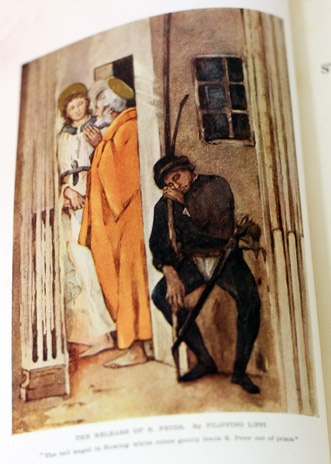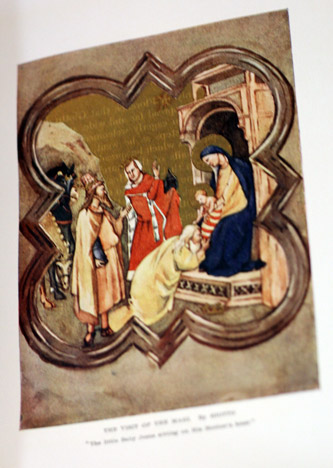A famous book introducing Renaissance art to children. Also a rewarding read for adults.
Contents:
GIOTTO, BORN 1276, DIED 1337
FRA ANGELICO, ” 1387, ” 1466
MASACCIO, ” 1401, ” 1428
FRA FILIPPO LIPPI, ” 1412, ” 1469
SANDRO BOTTICELLI, ” 1446, ” 1610
DOMENICO GHIRLANDAIO, ” 1449, ” 1494
FILIPPINO LIPPI ” 1467, ” 1604
PIETRO PERUGINO, ” 1446, ” 1624
LEONARDO DA VINCI, ” 1462, ” 1619
RAPHAEL, ” 1483, ” 1620
MICHELANGELO, ” 1476, ” 1664
ANDREA DEL SARTO, ” 1487, ” 1631
GIOVANNI BELLINI, ” 1426, ” 1616
VITTORE CARPACCIO, ” 1470? ” 1619
GIORGIONE, ” 1477? ” 1610
TITIAN, ” 1477, ” 1676
TINTORETTO, ” 1662, ” 1637
PAUL VERONESE, ” 1628, ” 1688
About the book (from preface):
What would we do without our picture-books, I wonder? Before we knew how to read, before even we could speak, we had learned to love them. We shouted with pleasure when we turned the pages and saw the spotted cow standing in the daisy-sprinkled meadow, the foolish-looking old sheep with her gambolling lambs, the wise dog with his friendly eyes. They were all real friends to us.
Then a little later on, when we began to ask for stories about the pictures, how we loved them more and more. There was the little girl in the red cloak talking to the great grey wolf with the wicked eyes; the cottage with the bright pink roses climbing round the lattice-window, out of which jumped a little maid with golden hair, followed by the great big bear, the middle-sized bear, and the tiny bear. Truly those stories were a great joy to us, but we would never have loved them quite so much if we had not known their pictured faces as well.
Do you ever wonder how all these pictures came to be made? They had a beginning, just as everything else had, but the beginning goes so far back that we can scarcely trace it.
Children have not always had picture-books to look at. In the long-ago days such things were not known. Thousands of years ago, far away in Assyria, the Assyrian people learned to make pictures and to carve them out in stone. In Egypt, too, the Egyptians traced pictures upon the walls of their temples and upon the painted mummy-cases of the dead. Then the Greeks made still more beautiful statues and pictures in marble, and called them gods and goddesses, for all this was at a time when the true God was forgotten.
Afterwards, when Christ had come and the people had learned that the pictured gods were not real, they began to think it wicked to make beautiful pictures or carve marble statues. The few pictures that were made were stiff and ugly, the figures were not like real men and women, the animals and trees were very strange-looking things. And instead of making the sky blue as it really was, they made it a chequered pattern of gold. After a time it seemed as if the art of making pictures was going to die out altogether.
Then came the time which is called ‘The Renaissance,’ a word which means being born again, or a new awakening, when men began to draw real pictures of real things and fill the world with images of beauty.
Now it is the stories of the men of that time, who put new life into Art, that I am going to tell you–men who learned, step by step, to paint the most beautiful pictures that the world possesses.
In telling these stories I have been helped by an old book called The Lives of the Painters, by Giorgio Vasari, who was himself a painter. He took great delight in gathering together all the stories about these artists and writing them down with loving care, so that he shows us real living men, and not merely great names by which the famous pictures are known.
It did not make much difference to us when we were little children whether our pictures were good or bad, as long as the colours were bright and we knew what they meant. But as we grow older and wiser our eyes grow wiser too, and we learn to know what is good and what is poor. Only, just as our tongues must be trained to speak, our hands to work, and our ears to love good music, so our eyes must be taught to see what is beautiful, or we may perhaps pass it carelessly by, and lose a great joy which might be ours.
So now if you learn something about these great artists and their wonderful pictures, it will help your eyes to grow wise. And some day should you visit sunny Italy, where these men lived and worked, you will feel that they are quite old friends. Their pictures will not only be a delight to your eyes, but will teach your heart something deeper and more wonderful than any words can explain.









